Wagner cast iron cookware is regarded by many as some of the finest examples of 19th and 20th century cast iron. Much of the cast iron is over 100 years old and still usable today. These antique pans are sought-after by enthusiasts who prefer vintage cast iron to newer pans. But identifying and dating these old Wagner Ware Sidney -o-pans can be tricky.
So, with this article, I hope to help you and other proud owners identify and give an estimate of the age of your cookware. You can also learn the history of your cast iron, which the Wagner Manufacturing Company manufactured.
Table Of Contents
- Wagner cast iron. “Why is it so collectible?”
- Learn the history of the Wagner Manufacturing Company.
- Where you can buy Wagner cast iron.
- Considerations when purchasing Wagner cast iron cookware.
- You can identify and date antique Wagner cast iron using trademarks and logos.
- Final thoughts on collecting vintage Wagner Ware cast iron.
But first, here is a quick look at the Wagner Manufacturing Company.
Identify And Date Your Wagner Cast Iron Skillets Using Logos. Also, Learn The Fascinating History Of Wagner Manufacturing.
Background To Wagner Manufacturing Cast Iron.
Founders | Milton M. Wagner and Bernard P. Wagner |
Operational Dates | The foundry in Sidney operated from 1891-1959 |
Located | The Wagner Manufacturing foundry was in Sidney, Shelby County, Ohio. |
Product Line | Wagner was one of the largest American manufacturers of cast iron products in the 20th century. Their product line included skillets, kettles, bean pots, Dutch Ovens, roasters, fruit presses, scoops, broilers, Griddles, waffle irons, muffin pans, and cornbread pans. The company also had a range of aluminum cookware. |
Wagner Brands | Wagner labeled their cookware under the following names: Wagner, Wagner Ware Sidney -o-, Wagner Ware, National, Long Life, Magnalite, Wardway, and Ward’s Cast Iron. |
Signature Products | Wagner is best known for the Sidney -O- range of skillets and Dutch Ovens. |
Reason For Closure | The reason for the closure of the foundry came from two fronts. Firstly, the Wagner family sold their interests in the company in 1953 to the Randell Company. Secondly, the company struggled financially because of a drop in sales. The decline in sales was due to two World Wars, the Great Depression, the development of new cookware materials, and the increase of lower-priced imports from Asia |
Wagner After Buyout (Non-Collectible) | In 1957, the Randall Company purchased long-term competitor Griswold from McGraw Edison. The Randall Company sold the cast iron businesses to Textron Corp in 1959. General Housewares Corporation bought Textron in 1969. In 1994, the production of Wagner Ware ended. |
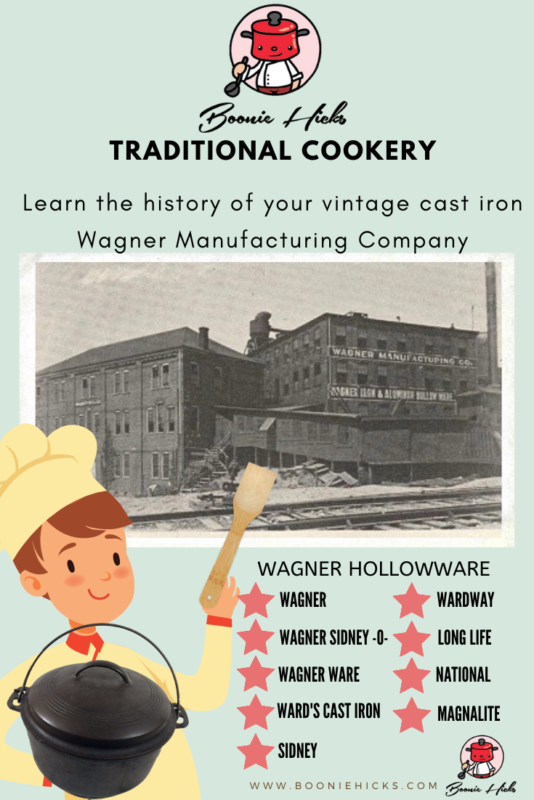
Why Is Wagner Cast Iron Collectible?
Super Smooth Cooking Surface.
Wagner cast iron is highly collectible. Like most antique cast iron, Wagner manufactured high-quality cookware for their entire range of cast iron products.
Unlike Wapak cast iron ironware, it often has characteristic casting flaws. Wagner cast iron tends to have a few casting flaws, resulting in very smooth cookware on both the interior and exterior of the cookware.
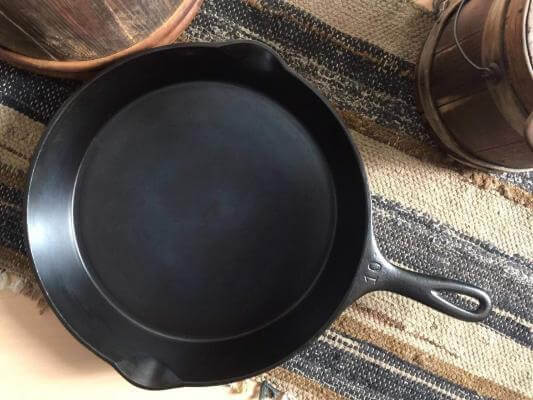
Focus On Quality
Imagine that workers would have worked on individual pieces of ironware. It was machined to smooth the interior and exterior of each pan. You can only see this level of detail in high-end cast iron cookware such as Le Creuset and Staub.
Today, Le Creuset and Staub benefit from combining traditional and modern manufacturing methods. However, the workers at Wagner could make cast iron cookware without casting flaws or bubbles. Must have taken great skill and attention to detail.
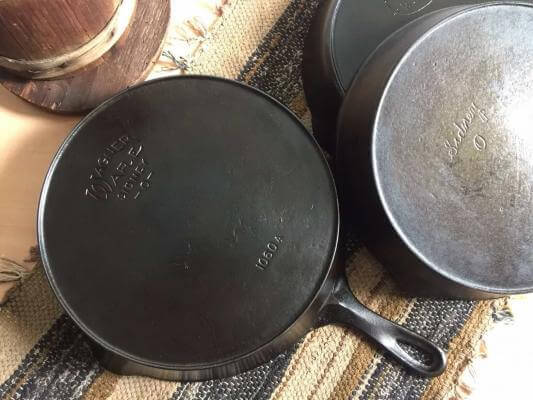
Wagner Made A Wide Range Of Cast Iron Cookware.
You can’t go wrong with an old Wagner cast iron skillet. It will serve you well for years, and they’re great fun. However, you may want to consider a Wagner Dutch oven. They are super smooth, and just like the skillets, they are reasonably priced. You can also buy cast iron muffin pans, which can be pretty cheap. But watch out for shipping costs that can increase the overall price drastically. Some of Wagner cast-iron cookware range includes:
- Dutch ovens
- Griddles
- Gem pans
- Waffle irons
- Skillets
You can even collect Wagner cast iron cornbread pans that look like corn cobs. Wagner Manufacturing also produced aluminum cookware, which must have seemed revolutionary.
Collect Your Favorite Logo.
If you want a vintage skillet, then Wagner skillets are a great choice. You can choose from sixteen different logos and trademarks or markings. I like pans with heat rings, while others may prefer a pan with a smooth base.
I think this wide selection makes Wagner cookware more collectible than other manufacturers, such as Vollrath and Martin Stove and Range, which manufacture a limited range of products.
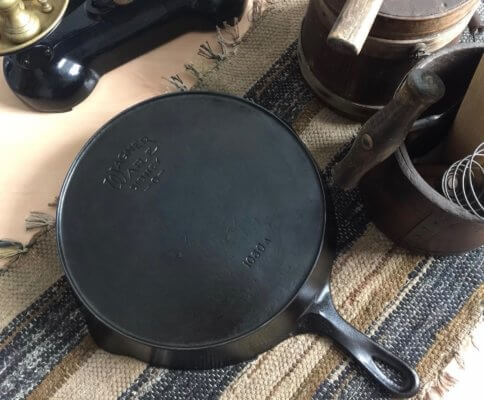
Wagner Manufacturing Company Focused On Quality Over Quantity.
Quality was a focus from the very start for Wagner Manufacturing Company. They even advertised this selling point to consumers. Old advertisements read;
We do not strive to manufacture hollowware as cheaply as possible but as well as it can be made. We cannot afford to put on the market ware that will not sustain our reputation. The name Wagner is on the bottom of each piece of ware.
Wagner Manufacturing Company History
Founders And Foundry
Who Founded Wagner Manufacturing? | Wagner Manufacturing Company was founded in 1891 by Milton M. and Bernard P. Wagner. However, two more Wagner brothers, Louis and William Wagner, joined the company in the following years. Another key player in the foundation of the company was R. Bingham. Bingham previously worked at Marion Stove Company and the Sidney Manufacturing Company. |
Where Was Wagner Cast Iron And Wagner Ware Made? | The company had its ironworks in Sidney, Shelby County, Ohio. Early cookware from Wagner Manufacturing had a simple Wagner marking on the back of the ironware. Wagner included Sidney O. in their cookware around 1895. The term Wagner Ware first appeared in the logo in the 1920s. |
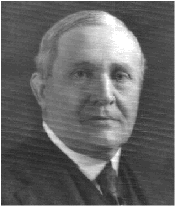
The Wagner Product Line Added Nickel Plating, Aluminum, And Magnalite.
Nickel-Plated Cast Iron | To complement their cast iron range, Wagner added a nickel-plated range. Unlike cast iron and copper pots, nickel plating does not react to acidic foods such as tomatoes, which can taint food. It’s easy to look past the development of nickel-plating. But, in the 19th century, bonding two metals together would have required much metal casting expertise. |
Aluminum Cookware | Along with nickel-plated cast iron, the Wagner brothers in 1894 manufactured a line of aluminum cookware, and Wagner Manufacturing was one of the first companies to do so. |
| Aluminum Cookware Exported To Europe | By 1913, Wagner cast iron and aluminum products were selling in Europe. |
| Magnalite | In the 1930s, Wagner manufactured a cookware line with a patented aluminum alloy called Magnalite. |
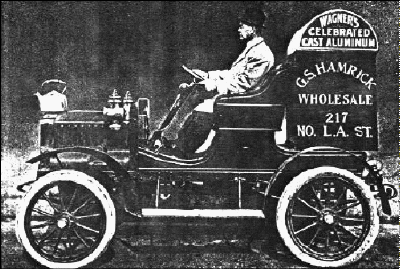
Wagner Manufacturing Buys Their Sidney Competition.
| Wagner Bought Sidney Hollowware Company. | In 1897, Wagner bought the Sidney-based competitor Sidney Hollow Ware Co. from the founder and owner Phillip Smith. Sidney Hollow Ware made high-quality cast iron cookware that was extremely light and smooth. Sidney Hollow Ware Co. was also an early adopter of nickel-plating cast iron. |
Why Did Wagner Buy Sidney Hollow Ware Company? | It was a brilliant idea to buy the Sidney Hollow Ware Company. After all, Wagner Manufacturing and Sidney competed in the same city and made comparable products. However, it was common knowledge that Smith made a tidy profit from his original investment in the foundry. To run the Sidney Foundry, William H. Wagner joined the family business to oversee the operation. |
Wagner Sold Sidney Hollow Ware Back To Phillip Smith. | In 1903, Wagner Manufacturing sold the Sidney Hollow Ware Company to the founder, Phillip Smith. Sadly, Phillip Smith did not reopen the foundry due to health reasons. |
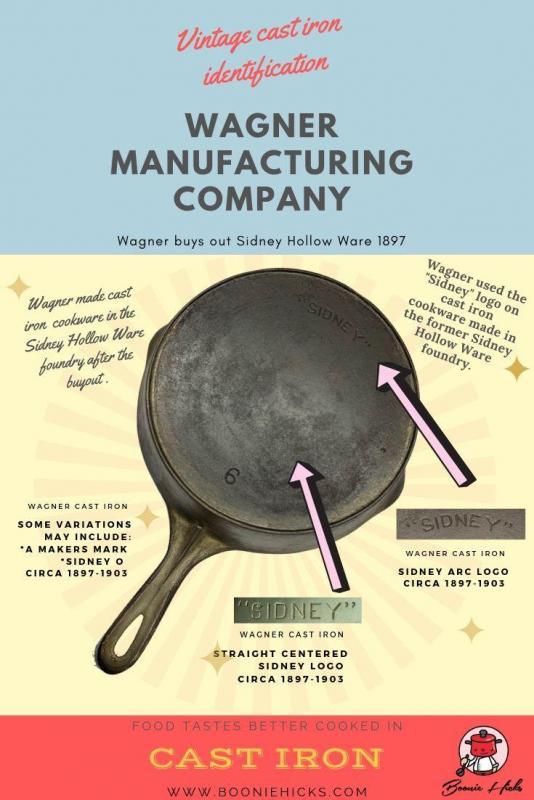
Wagner Introduced A New Product Line To Stop A Decline In Sales.
| The Great Depression (Magnalite) | I have to take my hats off to Wagner because they introduced a new product line called Magnalite in one of the deepest recessions the world has ever seen. Wagner Manufacturing was steadfast in making only quality products. For this reason, the cookware is collected and highly usable. |
| The Sales Decline | Wagner introduced Magnalite to stop falling sales at Wagner Manufacturing; it was not due to their product range. Magnalite was hugely popular, but it could not offset the effect of the worldwide recession. From 1929-1941, the US was in the grips of what we now call the Great Depression. Therefore, it was not only Wagner. However, many foundries struggled financially to survive. Many didn’t. |
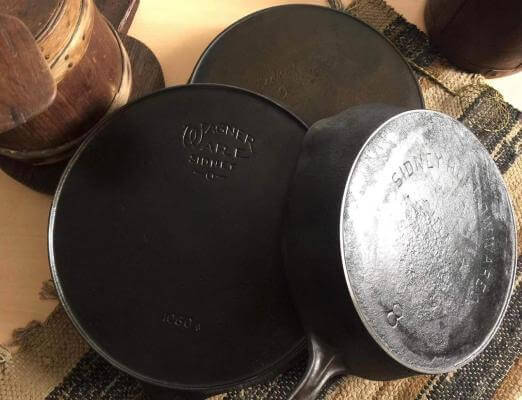
The Family Sells Their Interest In The Foundry.
Wagner Family Sells The Company To Randall Corp. | Wagner Manufacturing Co. lasted longer than many foundries. However, in 1952, Wagner was sold to the Randall Company. Unbelievably, the Randall Company was a car parts manufacturer. |
Textron Buys Randall | In 1959, another business called Tetron bought Wagner. Textron also purchases Griswold Manufacturing Company. At this date, cast iron enthusiasts consider this the end of Wagner Ware production. Wagner cast iron pans made after this date are considered not collectible. |
General House Wares | General Housewares Corporation in 1969 bought the rights of Griswold and Wagner. |
Is Wagner Ware Still Made? | With the world rediscovering cast iron cookware, will we see Wagner Ware skillets manufactured again? General Houses Ware stopped the manufacture of Wagner Ware in 1994. However, there is a glimmer of hope for Wagner Ware. In 2014, American Culinary bought both the Wagner and Griswold trademarks. So, fingers crossed, cast-iron fans may one day decide to manufacture Wagner cast iron again. |
Where Can You Get Your Hands On Some Wagner Ware?
- Grandparents (best deal and great to keep your heritage in the family).
- Antique stores (check online to compare the store price).
- Garage sales (rescue those poor skillets from the tip).
- Flea markets (search the markets for hidden gems).
- Online (largest selection available; however, asking prices can vary greatly.
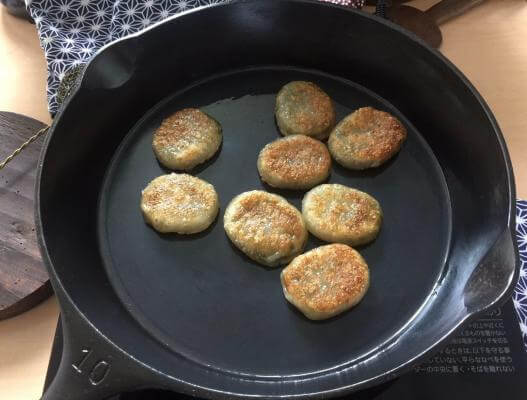
Buying Considerations Before You Buy Antique Wagner Ware
There Is Plenty Of Wagner Cast Iron Around, So Take Your Time.
There is no shortage of Wagner cast iron. Wagner had a large percentage of the cookware market back in its heyday. And plenty of fantastic Wagner skillets and Dutch ovens are in excellent condition.
What Size Skillet Or Dutch Oven Suits Your Needs?
The first thing you may want to think about is the size you need. There are often plenty of #8 skillets around. This size seems to be the most common for Wagner skillets and other vintage cast iron manufacturers, such as Favorite Piqua.
Inspect Carefully Since A Lot Of Wagner Ware Is Nickel-Plated.
Check the cookware carefully. The Wagner Manufacturing Company was an early adopter of nickel plating. However, most of Wagner cookware is unplated iron. Heavy seasoning may hide nickel plating. Nickel-plated can wear off or be patchy in places. Take a close look before purchasing.
Would You Like A Wagner Ware Skillet With A Smooth Bottom Or Heat Ring?
Do you want a pan with a smooth bottom or one with a heat ring? The older Wagner Ware skillets will have a heat ring, while the later-made pans have a smooth, flat base. It is a personal preference. I tend to like the older skillets with heat rings. They have more character, but the smooth-bottom Wagner cookware tends to be a little cheaper. And they are great cooking pans, too.
Does The Cookware Sit Flat?
As with all antique cast iron, asking the seller if the pan sits flat could be a good idea. A lever base is practical if cooking on a flat surface such as induction or glass.
Learn To Date And Identify Your Wagner Cast Iron Using Logos And Markings.
Although I’ve researched carefully, please only use the dates as an approximation.
Wagner cast iron cookware, to my knowledge, has sixteen known logos, brands, or markings. These include:
Straight Wagner Logo 1890s-1915
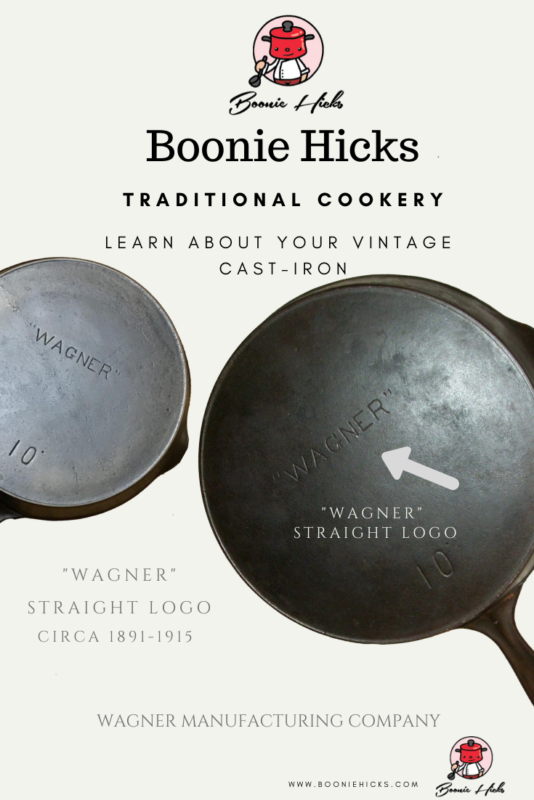
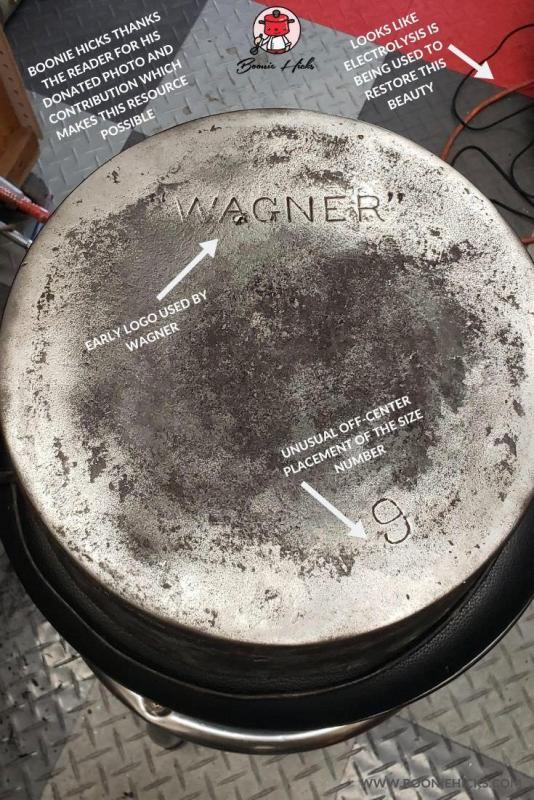
Wagner Arc Logo 1891-1910
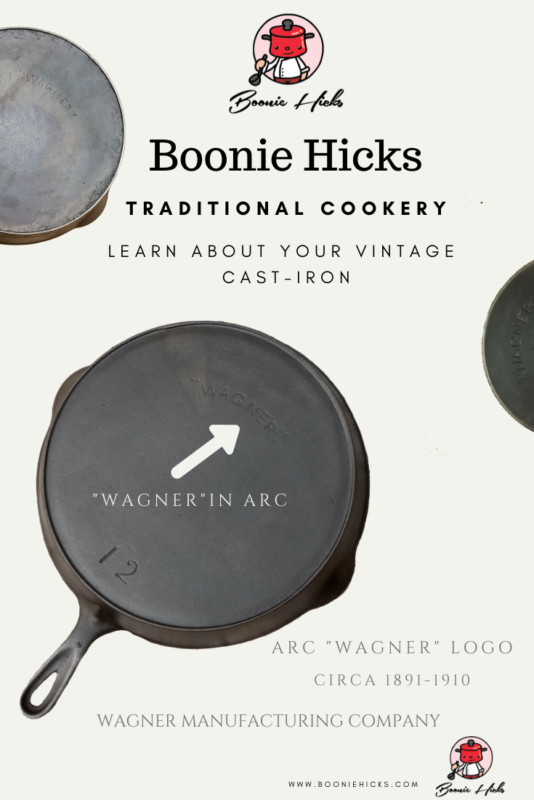

Double Arc Wagner Sidney O 1895-1915
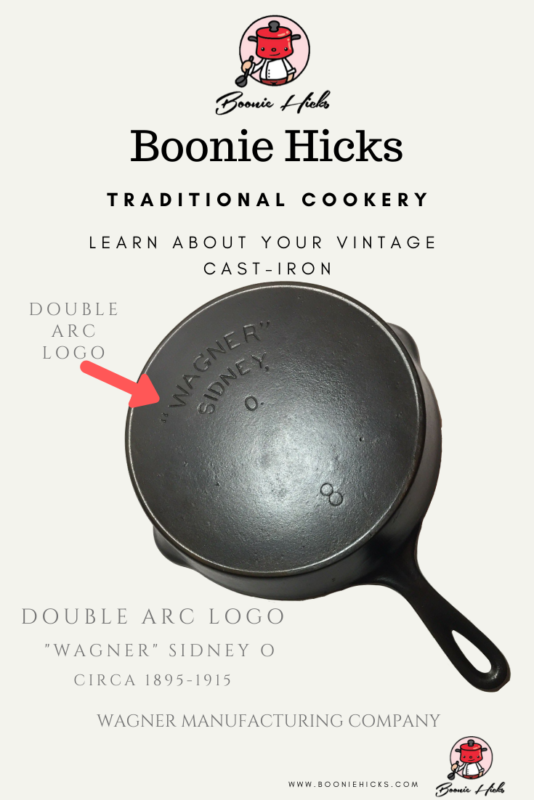
Sidney Arc logo Circa 1897-1903.
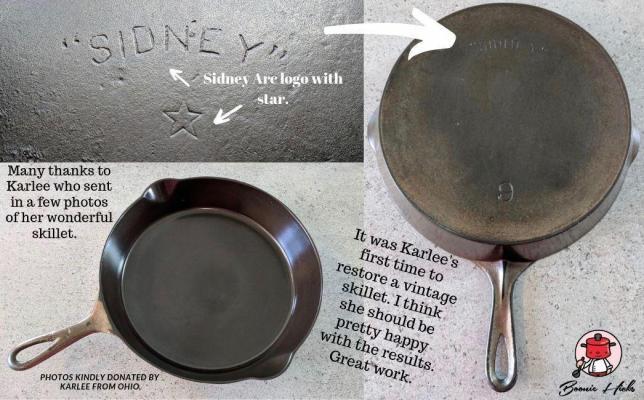
Straight Sidney Logo Circa 1897-1903.
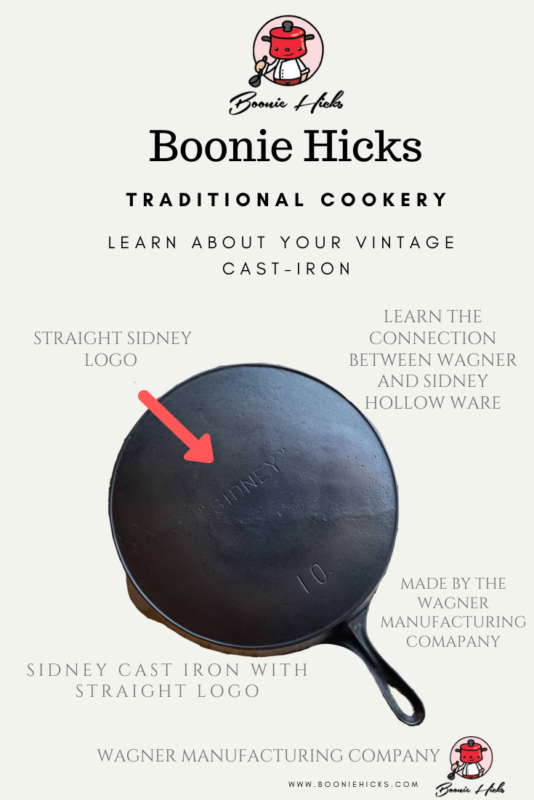
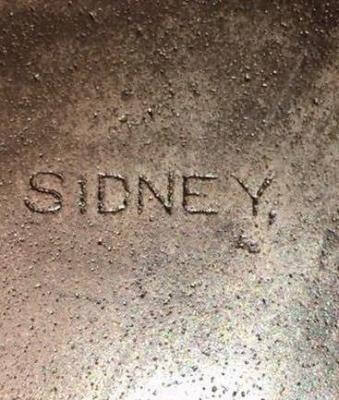
Straight Wagner Sidney O. (Centered.) 1910-1915
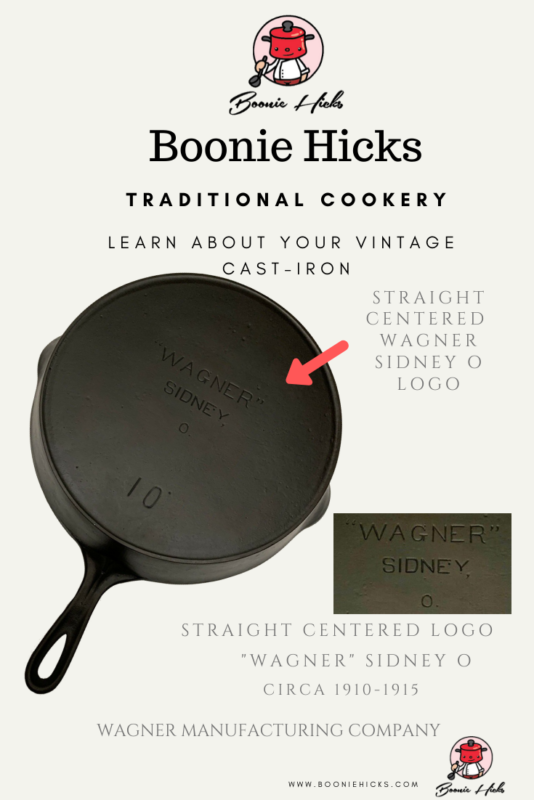
Wagner Sidney O. Wagner Slightly Arced While The Sidney Lettering Is Straight. Circa 1915-1920s
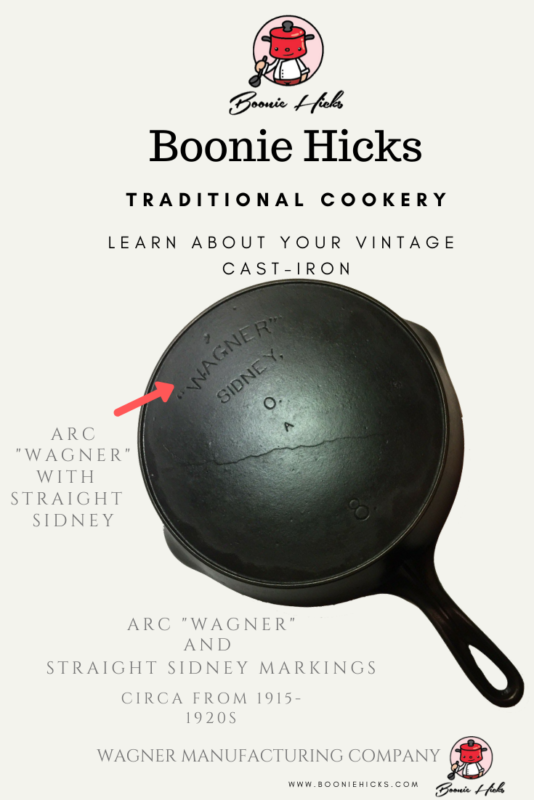
First Wagner Ware Sidney O. With Arc Wagner And Straight Ware And Sidney. Circa 1920s.
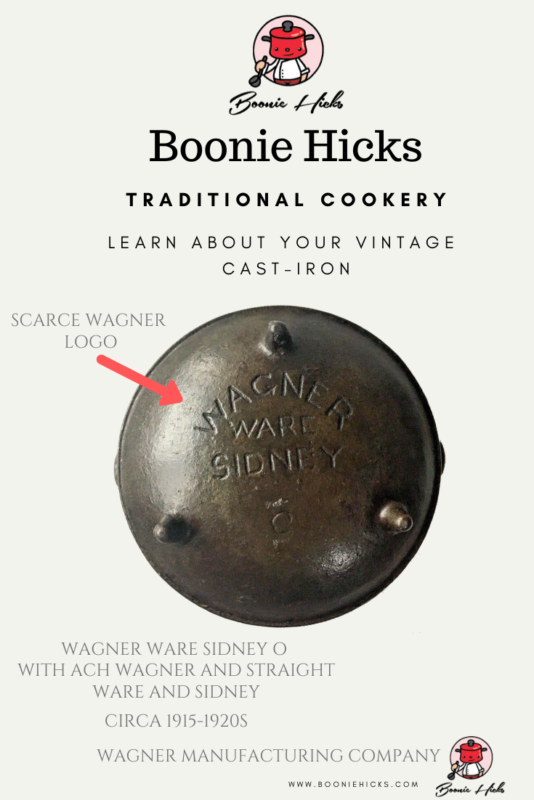
Stylized Wagner Ware Sidney O. for regular skillets. Circa 1920-1924 with heat ring and single-digit size number. 1924-1935 with a heat ring and a four-digit pattern number. Around 1935-1959, for skillets with no heat ring.
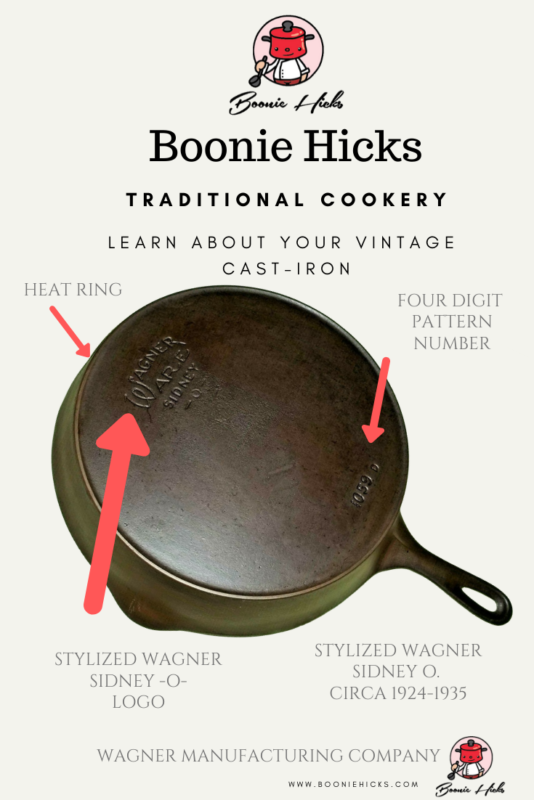
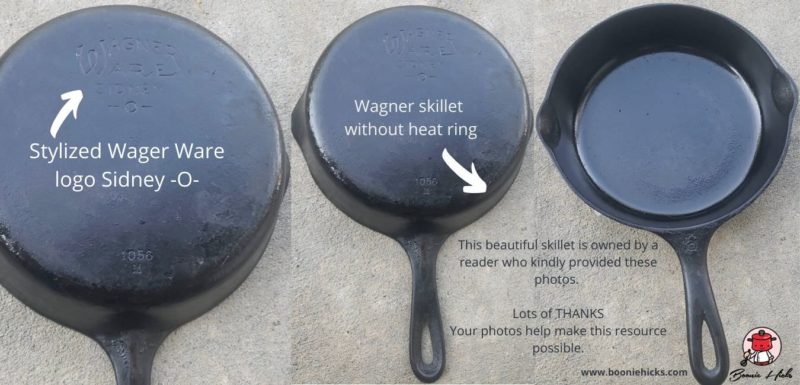
Centralized Stylized Wagner Sidney O. 1924-1935 With Heat Ring.
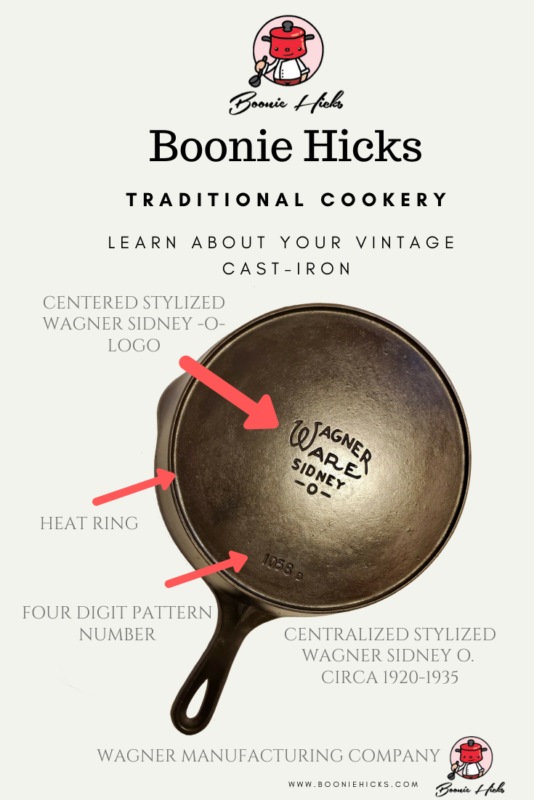
Pie Logo 1924-1934. However, Manufacturing Dates Are Uncertain.
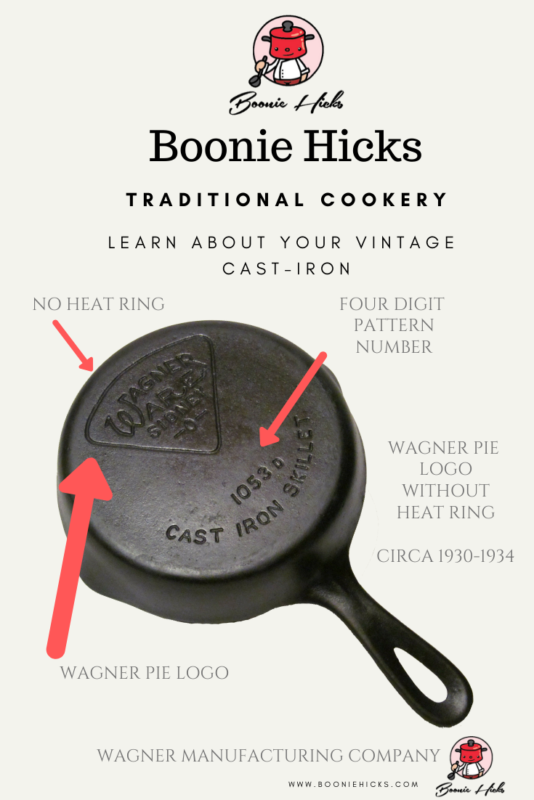
National Cast Iron Dates Between 1914 and 1940s
There are several different versions of cast iron with the National marking. Wanger marketed the Nation brand as entry-level cookware for budget-conscious consumers. Wagner made the National line circa 1914 to 1940.
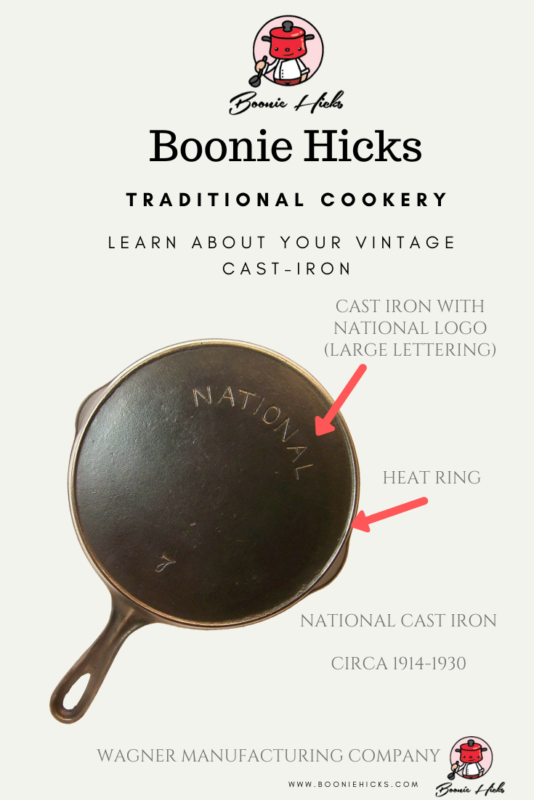
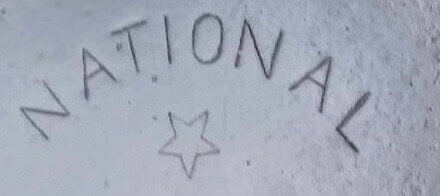
Long Life Logo 1930s.
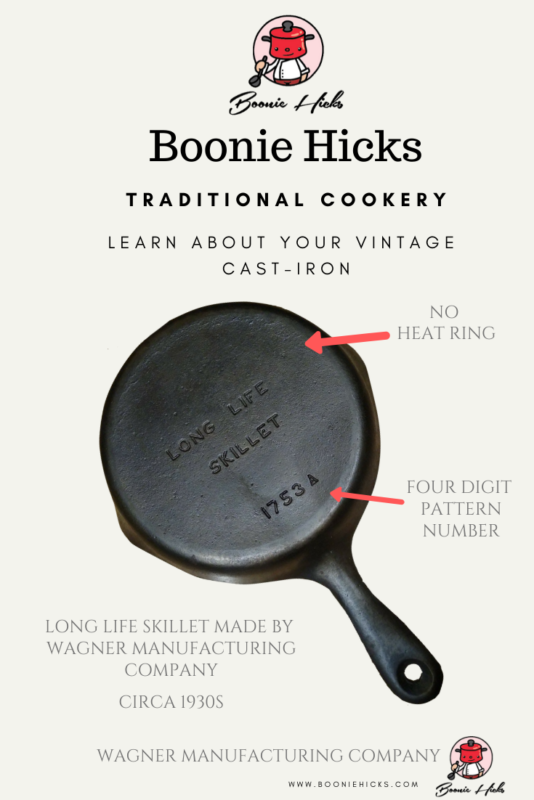
Wardway and Montgomery Ward. The Montgomery Ward Department store contracted Wagner Manufacturing Company to produce an in-store label. Circa the 1930s.
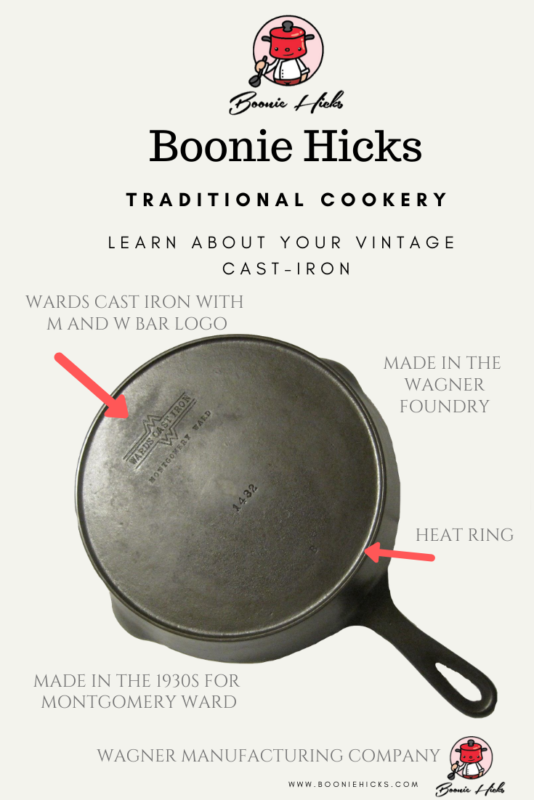
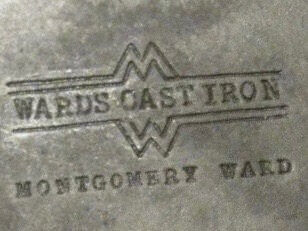
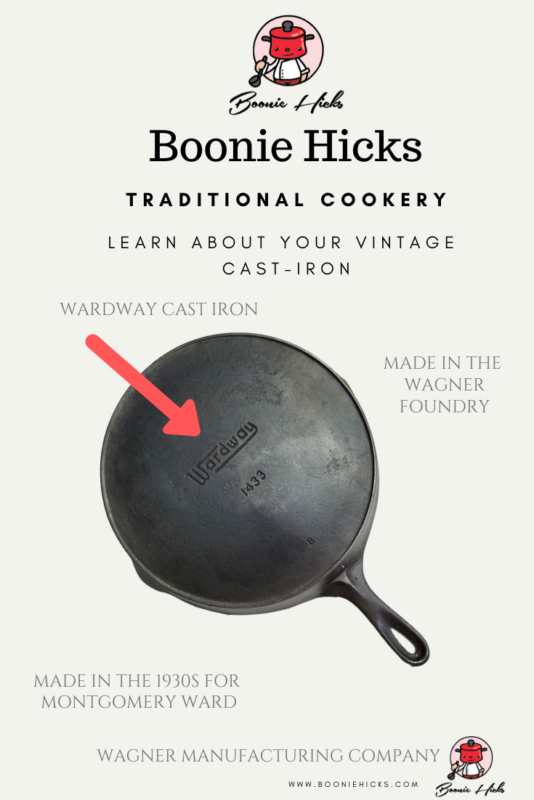
Final Thoughts On Wagner Cast Iron.
Fortunately, Wagner cast iron is more straightforward to date than other foundries of the time. Wagner Ware also has a huge collector base, so dates are well documented. The Cast Iron Collector is a valuable online resource for enthusiasts. Also, there are Facebook groups where you can share your love of cast iron cookware.
The Wagner Manufacturing Company was known for quality over quantity. Therefore, it has a good reputation for making trustworthy products.
Today, collectors and enthusiasts seek out Wagner cookware. However, you don’t need to be a collector to enjoy vintage cast iron. Here are six reasons why Wagner Ware is excellent ironware.
Although many cast iron enthusiasts look for Wagner-made skillets. But you’re not limited there. Wagner Manufactures a wide selection of cast iron cookware. You may find yourself becoming interested in:
- muffin pans
- Dutch ovens
- Scotch bowls
Since Wagner made some of the finest cast iron of the 19th and 20th centuries, Wagner ironware is still sought-after by cast-iron fans and hobbyists alike.

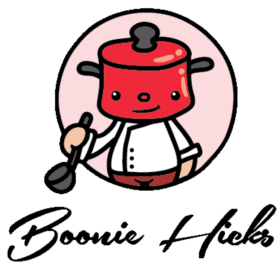
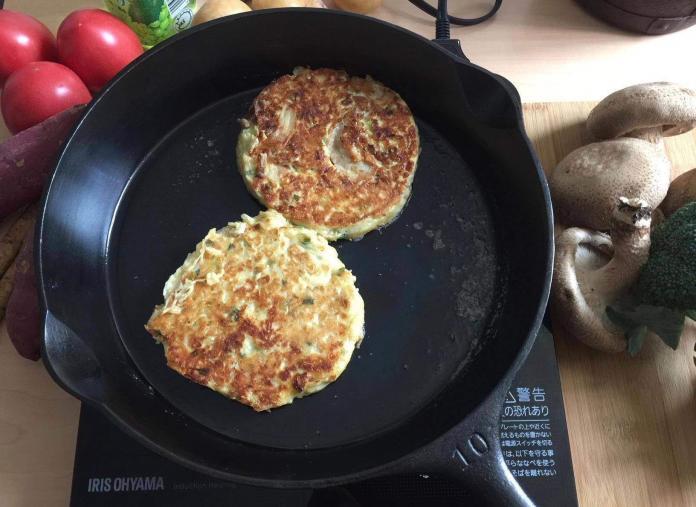
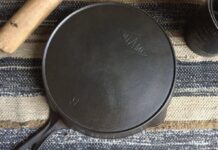
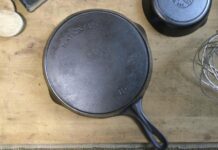
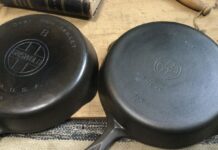



Did Wagner make an aluminum cup? I ran across a metal cup I thought looked pretty cool and picked it up. The logo on the the bottom says:
WAGNER
MFG CO
SIDNEY O
The Wagner and the Sidney O are arched.
Hi Wayne
Thanks for the question
I had to get the reference books out for this one. It looks like Wagner made big and small aluminum cups matching your description. You’re looking around Circa 1910s.
You’re right very cool.
Thanks for the info.
I just picked up a waffle maker. On one side it has “THE WAGNER” around the outside and the inner circle has “No8. 8 & 9”. The other sides outer circle has “WAGNER M’F’G CO SIDNEY O”. The inner circle is harder to make out but looks like “PAP D” “JULY 26 1892” or maybe “1899”.
I still have a ways to get it cleaned up. It has a coating that I am trying to figure out how to remove. Wooden handles makes my go to remedies unfeasible. I don’t think I have ever seen a date on Wagner before and this is the first waffle maker I have seen. Any ideas on removing the coating it seems to be flaking off in some places and of course that is where a bit of rust is hiding.
Hi James
It sounds like you have an old Wagner Waffle iron (circa 1900). But hopefully the handles can still unscrew so, you can continue with your restoration process.
If the coating is different from your other restoration projects then you may need to be careful.
Around this time people used leaded paint on metalware such as cast-iron stoves to prevent rust and to make it look shiny. So, if you think the waffle iron is painted then I would be hesitant to use your cooking oven or outdoor grill to burn off the paint. I think you would need a hotter temperature anyway.
I’d pick up a home lead testing kit from the paint section in your hardware store. If the staff look knowledgable I’d ask them how to safely remove leaded pain from cast-iron.
If it’s normal seasoning and you can’t get the handles off. Try a 50/50 solution of water and white vinegar and let your waffle iron soak for a couple of days.
Hope this helps.
I have a Wagner Ware skillet # 8, but does not have Sidney O under the Wagner Ware on bottom and no ring on bottom either. Is it a real Wagner Ware?
Hi Jeff
Thanks for getting in contact.
Interesting question. If you send through a couple of pictures I’ll take a closer look at it for you.
booniehicks@gmail.com
Cheers
I have a roaster that has Wagner Ware Sidney -o- and then towards the bottom has Magnalite 4265 M. Can you tell how old it is? And any thing about this roaster. I love the roaster it is my favorite!
Hi Esther,
Wagner Magnalite owners love their cookware and are just as passionate about their cookware as cast-iron enthusiasts.
To be honest, I don’t know much about Magnalite. However, I’m sure if we look at the logo and put it into context with what was happening around the world at the time and we can narrow it down to an approximate date.
Stylized Wagner logo circa around mid-1930s-1950s
Economic challenges late 1930s early 1940s
Possible resources diverted and rationing 1942-1944s (I have fond memories of my Grandmother reusing her teabags).
At a guess, I’d place your Magnalite around 1945-1957. A time when life is getting back to normal, there was an uptake in technology and many young families needing a big 8-quart roaster for that yummy Sunday roast.
I hope this helps. Enjoy your Magnalite, Ester.
I have a Wagner 10 1/2 in skillet that has seasoning instructions on the bottom. Is that a real Wagner or a knock -off???
Thanks
Hi Claire
Thanks for getting in touch.
Your Wagner’s 1891 original skillet was probably made between 1991-1999 by a company, which at the time held the rights to the Wagner line (General Housewares Corp). It’s an interesting piece but unfortunately it’s not considered a vintage Wagner skillet.
But there’s good news…There are many old pans around looking for a loving, caring home. Keep an eye open for them.
My mom has a Wagner -0- 1059f on the back and #9 on the handle.
That’s a nice pan and I bet she’s a pretty good cook too.
I have a pan with no manufacturer’s name, but marked “10 1/2 INCH SKILLET”, straight across.
No “Made in USA” marking.
I understand this is likely to be a Wagner pan sold by lower prestigious retailers.
Cooks just FINE! Can you verify my suppositions?
Hi Will thanks for the question
I’m really glad you’re enjoying your skillet. I think your suspicions could be correct. Wagner made a lot of unmarked cast iron. I guess the placement of the “10 1/2 INCH SKILLET” is at the 6 o’clock position. Check for a single letter under this marking and on the backside of the handle which is another identifying mark on unmarked Wagner skillets.
Cheers hope this helps.
I happened to be reading your article, trying to date my National Wagner Ware Sidney O pan, and I noticed you have a picture of 1358A, and I have 1359A! I found it while on vacation in Idaho at a goodwill. Too funny!
Hi April
Thanks for sending a message. I’m really happy you found the information useful.
Picking up a vintage Wagner at a goodwill, great find that’s my kind of vacation. Those National skillets are fine looking pans.
Enjoy your number 9
I have an old 8 inch gate marked skillet that plainly has WAGNER imprinted on the bottom, Very crude and with a small arch, I’ve been told Waghner made no gate marked skillets, Just want to know if this is true.
Thanks- Charles Walker
Hello, thanks for your question Charles.
I would have to agree with the person you have spoken to. I don’t think Wagner gated any of their cast iron skillets.
Wagner opened their foundry in the late 19th century and would have adopted the latest technology and techniques. Foundries such as Griswold, Marion and Sidney Hollowware were already producing cookware without gate marks before Wagner operated. So I don’t think you’ll find many pieces of Wagner iron with gate marks.
Thanks for sharing.
Brett
I came to your blog as the result of my neighbor handing me a Wagner Ware #10 Drip Drop Roaster that she had no longer wanted. It’s in perfect condition although lightly rusted. It has the stylized logo and is marked on the underside of lid and bottom of roaster 1270 a. I’m not concerned about the value although I would love to know the approximate age.
Hi Dale
Thank’s for your contact. It sounds like your neighbor’s old Dutch oven has found a good home. Those #10’s hold 8 quarts, that’s a nice size for a family gathering. From my understanding, Wagner Drip Drop Roasters were made in the 1920s. I think yours is round but Wagner also made oval roasters.
I’m sure your neighbours will be inviting themselves over when winter arrives for a nice bowl of soup.
Enjoy your vintage Dutch oven.
I have a Wagner #9 with a painted eagle on the back and along with 3 gold stars.
Do you know anything about it. It has never been used.
Hi Jimmy
Sounds like you have a nice piece of Americana. I could be wrong but I’m unaware of any painted commemorative cast iron. I’d place my bets it was painted for decorative proposes and used for display. I’ve seen a few painted skillet but I mostly come across this style of folk art on antique firkin buckets and old pantry boxes.
Thanks for sharing, enjoy your skillet.
Perhaps someone here can lend a hand. I recently bought an 1890s vintage Wagner, straight logo #8 skillet. As might be expected in its 120-130 year lifetime, it had been tossed in the fire and overheated. There are a couple small damaged areas of “red” iron. I’d really like to save this skillet. The one time I tried to season a red skillet, I had little success. I’ve run this one through electrolysis and lye, so it’s clean. Any ideas?
Hi Farmer
I haven’t had any experience seasoning cast iron with fire damage. Hopefully someone can share their expertise.
Cheers
I have a Wagner 1359c, with national spelt without the i. Just curious about the age of it
Hi there Bree thanks for getting in touch.
It sounds like you have a No9 dual logo. With no “i” hey that’s neat.
There are quite a few different versions of National skillets. Because your skillet has a pattern number “1359c” I’d say your pan was made Circa 1930s to mid-1940s.
Cheers Bree enjoy your vintage cast-iron.
I have a cast iron skillet with just a “w” on the bottom. Any idea what that might indicate?
Hi Kim
Thanks for your question.
A single letter at the base of a skillet could be an indication of which mold used to make the cookware. If there was a problem with the casting workers could quickly identify the suspect mold and remove it from production without stopping the line. Or a molder’s mark probably an initial of the makers name.
Many unmarked Lodge skillets have a single raised single letter around the 6 o’clock position and a raised number on the handle. Other old Lodge skillets may have a single notch in the heat ring at the 12 o’clock position. Or three notches in the heat ring at 12, 3, and 9 o’clock position.
Hope this helps
I have an heirloom skillet I’d like to date and value. The logo is the stylized Wagner logo situated at 12:00 without the Sydney stamp. It simply says Wagner Ware. At 6:00 there are 2 lines in block lettering saying 13-1/2 INCH SKILLET, MADE IN U.S.A. The number 12 is stamped on the handle. Any ideas as I’m unable to determine through internet searches.
Hi, Kelley
Thanks for the question. It sounds like your piece was made in or after the 1960s. A regulation was passed during the time requiring manufacturers to indicate the country of manufacture, probably because of lower cost and quality imports coming out Asia at the time.
Wagner Ware cast iron with made in the U.S.A., unfortunately, holds less value than the older Wagner Ware Sidney O pieces and was made after Wagner sold of their patents and naming rights to another company. However, larger skillets such as your No 12 often sell at higher prices depending on condition.
A good place to see current value is the sold listings on eBay. Just keep in mind online prices are often higher than other methods of buying or selling.
Hope this helps
I have a smooth bottom Wagner #3 that has it name on top side of handle. Do you have any information on it?
Hi, Jane thanks for the contact.
You have a really interesting old Wagner. Unfortunately, I don’t have any information on your piece. Hopefully, another collector will read the comments and can shed more light on your ironware.
Enjoy your Wagner
I have several Wagner Cast Iron pieces that I am trying to date and determine if they are made with nickel. All have smooth bottoms. Two have WAGNER’s 1891 Original with seasoning instructions. The other is a Wagner Ware, Sidney -O- numbered 1268 J. Are you able to help me with this?
Hi Bridget
Thanks for your question.
Your Wagner Ware 1268 J. is the older of your cast iron holloware. As a rough estimate, I’d say your Dutch oven is circa 1935-1959. Some collectors may date the Wagner stylized logo as early as the 1920s. However, I prefer to give a conservative estimate to avoid disappointment.
Unfortunately, you may be disappointed with your 1891 Wagner cast iron original. These are commemorative pieces celebrating Wagners 100th Anniversary. They were probably manufactured from 1991-1999 and not considered collectable. However, I’m sure it’s a great pan to use.
Nickel-plated cast iron is very noticeable and will have a tin or shiny appearance. However, regular unseasoned cast iron is also quite shiny. I’d recommend you compare your Dutch oven with a few Google images. It could be worth noting that chromium and nickel are still used to make modern stainless steel cookware to this day.
Hope this helps
I have a stylized Wagner ware No.8 Drip Drop Roaster made of Magnalite. Can you tell me when it was made and possibly cost ?
Hi R.W.
Thanks for your question
I hear those who use Maganlite are just as passionate about their cookware like us cast iron collectors. I tend to stay away from giving an estimate on the value of vintage cookware. The sold listings on eBay can give you an indication of Magnalite values of similar condition and those with plastic and metal knobs.
Have a look at the bottom of your Wagner Drip Roaster. Because Wagner made a large range of aluminum cookware before introducing the Magnalite range. It sounds like your Drip Roaster will have a stylized logo and read Round Roaster or Oval Roaster without Magnalite circa 1920s-1940s.
However, if the bottom has Wagner Ware + Magnalite it was made circa 1930s-1970s. Magnalite is around 94 percent aluminum with the remainder being a magnesium alloy.
Hope this helps
How much are these worth?
Hi there Tara
Thanks for your question.
I’ll be honest some of the larger Wagner skillets with a heat ring or one with a rare logo can cost as much as Le Creuset skillet. A fair chunk of change.
However, please don’t let this put you off vintage cast iron cookware. Half the fun of collecting cast iron is finding hidden gems at garage sales at bargain prices. Also, you can pick up a #8 or #9 Wagner skillet at a much lower price compared to a large #12 Wagner skillet.
If you’re looking for good vintage skillet, Wagner cast iron could be a good choice. They often sell for less than Griswold cast iron but they are comparable in quality. I’d check out eBay sold listings to familiarize yourself with current selling prices.
Cheers Tara
Hello I have a Wagner #6 logo
Wagner
air
Sidney
The code on the other side of the pan is 1056Q
Are you able to tell me the year when it was made thank you Ken
Hi Ken,
Thanks for the question.
It sounds like you have a stylized logo. You didn’t mention a heat ring, so I’m guessing it’s a smooth bottom pan. I can’t give you a year but as a very rough timeline, I’d say the 1940s to mid-1950s.
Enjoy using your vintage pan.
Did they make a salesman sample corncob pan?
Hi Starlene,
Unfortunately, to my knowledge, Wagner didn’t make any. However, I’m happy if another collector can share their knowledge of Wagner toys.
You may know of the Wagner 100 Year Anniversary Toy Set (Wagner’s 1891 original) that includes a cornstick pan. Although it’s not considered a Wagner vintage collectable, it’s still cute.
Thanks for the great question.